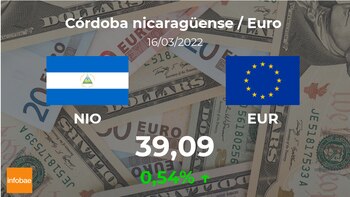
At the start of the day, the euro was paid at the opening at 39.09 Nicaraguan cordobas on average, which represents a 0.54% increase compared to the previous day, when it had closed with 38.88 Nicaraguan cordobas.
Compared to the profitability of the last seven days, the euro recorded an increase of 1.69%; on the contrary, year-on-year, it still maintains a fall of 6.06%. Compared to the previous days, it reverses the previous day's price, when it ended with a drop of 0.27%, showing itself unable to establish a clear trend on recent dates. As for the volatility of the past few days, it is higher than that accumulated last year, so it shows larger changes than the general trend in value.
Last year, the euro traded at a high of 40.43 Nicaraguan cordobas, while its lowest level was 38.44 Nicaraguan cordobas. The euro is closer to its minimum value than to the maximum.
Córdoba is the legal monetary unit in Nicaragua and is abbreviated NIO; it is divided into 100 cents and its transit is controlled by the central bank of that country.
The name of the coin comes in honor of the second surname of the Spanish conquistador, Captain Francisco Hernández de Córdoba, who also founded the cities of Granada and León.
Cordoba was created on August 25, 1908, under the mandate of the then president Adolfo Díaz, who issued a coin of 10 cordobas and replaced the peso. At the time, the new currency had a value of 5 cordobas per pound sterling.
On November 13, 1931, Cordoba began trading at a parity rate of 1.10 cordobas per US dollar, but after several devaluations, it rose to 7 cordobas per US dollar between 1946 and April 1979.
It was not until 1991 that the government, in turn, launched a successful monetary stabilization plan that managed to curb hyperdevaluation and achieve stability in prices, exchange rates and the currency. In January 1993, the country switched to the mini-assessment system, which has been 3% per year since 2019.
In the economic sector, Nicaragua recorded significant declines. In 2018 and 2019, gross domestic product decreased by -3% and in 2020 by -2%, although it increased slightly in 2021, the Nicaraguan economy is only above Venezuela.
In addition, under Daniel Ortega's current government, the World Bank has estimated that poverty has risen from 13.5% in 2019 to 14.6% in 2021. In addition to SARS-CoV-2, this country was also plagued by hurricanes Eta and Lota, which wreaked great havoc.
In addition to this scenario, the sanctions of the United States and the European Union on the nation led the country to ally itself with Venezuela, Cuba and China, which was tightened after the last elections in which Ortega won his re-election were called fraud.
According to a projection by the Economic Commission for Latin America and the Caribbean (ECLAC), Nicaragua, as well as Guatemala or the Dominican Republic, will not regain their economic level in 2022 as before the SARS-CoV-2 pandemic.
Keep reading:
Últimas Noticias
Debanhi Escobar: they secured the motel where she was found lifeless in a cistern

The oldest person in the world died at the age of 119

Macabre find in CDMX: they left a body bagged and tied in a taxi
The eagles of America will face Manchester City in a duel of legends. Here are the details

Why is it good to bring dogs out to know the world when they are puppies



